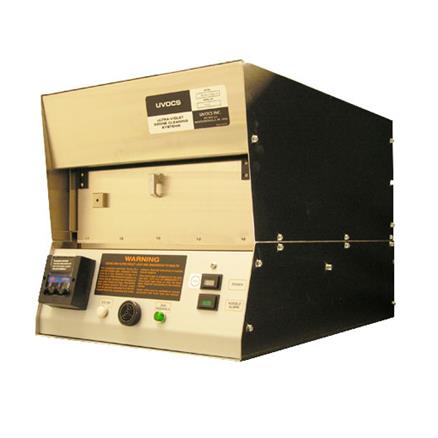- Intermittent lamp operation. Lamp and timer are activated by door closing;
- Sliding parts tray—smooth, low vibration ball-bearing system—height to 1 1⁄2 inches;
- Rugged all stainless steel construction;
- Long life, low pressure quartz-mercury vapor lamp emits 254 and 185 nm UV causing rapid oxidation and removal of trace organic residues;
- Total UV protection makes these units operator safe;
- Low initial equipment cost and low operating cost.

Ultraviolet ozone cleaning system
Ultraviolet / ozone cleaning provides a simple, inexpensive and fast method of obtaining ultra-clean surfaces free of organic contaminants. This process is ideal when thin film deposition with excellent adhesion to the surface is required. Ultra-clean surfaces can easily be achieved by UV/Ozone processing in one to several minutes after the surface has been cleaned by conventional techniques.
The system removes all traces of:
- Skin oil
- Silicone oil
- Grease
- Solder flux
- Residual photoresist
- Condensed adhesive volatiles
- Carbon traces
Applications
- Cleaning prior to thin film deposition on many surfaces
- The production of CD/DVD masters
- Hybrid substrates prior to wire bonding – removal of condensed epoxy volatiles
- Improving adhesion to plastic surfaces
- Production of GaAs and InP wafers
- Optical lenses production and handling
- Creating Thin Oxide on Silicon wafers Silicon Wafers
- Manufacturing and handling of OLEDs
How clean is "ultra" clean?
Contact angle measurements of 4-5 degrees. Miniscule peaks when measured with AES and ESCA. With steam test there are uniform rainbow-like fringes during condensation and evaporation. Often, cleaning of critical surfaces prior to other processing steps is considered finished after the usual scrubbing and ultrasoneration steps. UV/Ozone cleaning adds a valuable new dimension to cleaning that can prove itself in dollars and cents in improved performance and reliability in applications where UV/Ozone can be used after the standard cleaning operation.
How does ultraviolet / ozone cleaning work?
The heart of UVOCS cleaning equipment is a low-pressure quartz mercury vapor lamp, which generates UV emissions in the 254 and 185 nanometer range. Ozone and atomic oxygen are generated. Organic contaminant molecules are excited or dissociated by the absorption of the 254 nm wavelength UV. The excited organic contaminants react with the atomic oxygen to form volatile products such as CO2, H2O, etc. The whole process takes place at essentially room temperature* in one to several minutes.
*The temperature rise of parts is dependent on the length of processing time.
